????????元胞自動機是一種基于離散空間的動態系統,由許多簡單單元按照某些規則進行相互作用和演化而形成的復雜結構。元胞自動機可以用于模擬物理、生物、社會等領域的現象,以及進行優化、圖像處理、噪聲生成等方面的應用。
例1:生命游戲
nextStateCalculation.m
% 下一個狀態的計算函數
function nextState = nextStateCalculation(currentState)[m, n] = size(currentState);nextState = zeros(m, n);for i = 1:mfor j = 1:n% 統計鄰居細胞的存活數liveNeighbours = sum(sum(currentState(max(i-1,1):min(i+1,m), max(j-1,1):min(j+1,n)))) - currentState(i, j);if currentState(i, j) == 1% 活細胞規則if liveNeighbours < 2 || liveNeighbours > 3nextState(i, j) = 0; % 孤立或擁擠死亡elsenextState(i, j) = 1; % 繼續存活endelse% 死細胞規則if liveNeighbours == 3nextState(i, j) = 1; % 繁殖elsenextState(i, j) = 0; % 仍然死亡endendendend
end
主程序:
% 定義初始狀態
initialState = randi([0 1], 50, 50); % 50x50 的隨機初始狀態% 顯示初始狀態
figure;
imagesc(initialState);
colormap(summer);
title('初始狀態');% 模擬演化
numIterations = 100;
for t = 1:numIterations% 計算下一個狀態nextState = nextStateCalculation(initialState);% 顯示下一個狀態imagesc(nextState);colormap(summer);title(['第', num2str(t), '代']);pause(0.1);% 更新狀態initialState = nextState;
end
效果如下:
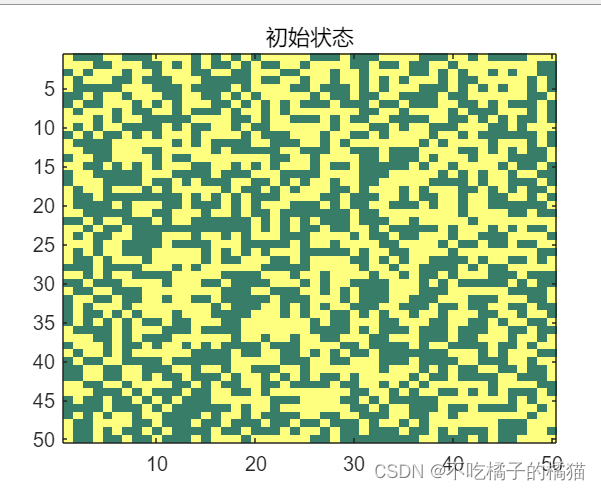

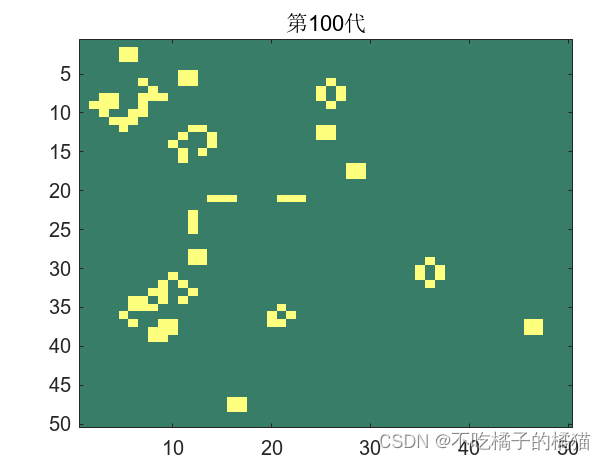
例2:森林火災(完全燒毀)
simulateForestFire.m
% 定義森林火災模擬函數
function simulateForestFire(rows, cols, pTree, pBurning, pIgnition, numIterations)% 初始化森林狀態forest = zeros(rows, cols); % 0代表空地,1代表樹木,2代表正在燃燒% 隨機生成樹木forest(rand(rows, cols) < pTree) = 1;% 隨機選擇一個樹木點作為起火點burningTree = randi([1, rows], 1, 2);forest(burningTree(1), burningTree(2)) = 2;% 模擬森林火災傳播過程for t = 1:numIterationsforest = updateForest(forest, pBurning, pIgnition);% 可視化當前森林狀態imagesc(forest);colormap([1 1 1; 0 1 0; 1 0 0]); % 白色-空地,綠色-樹木,紅色-著火title(['第', num2str(t), '代']);pause(0.1);end
endupdateForest.m
% 更新森林狀態
function newForest = updateForest(forest, pBurning, pIgnition)[rows, cols] = size(forest);newForest = forest;for i = 1:rowsfor j = 1:colsif forest(i, j) == 1 % 樹木% 根據周圍樹木著火情況更新當前點狀態if any(neighbors(forest, i, j) == 2) || rand < pIgnitionnewForest(i, j) = 2; % 著火endelseif forest(i, j) == 2 % 著火newForest(i, j) = 0; % 燃盡endendend
endneighbors.m
% 獲取鄰居狀態
function neighborStates = neighbors(forest, i, j)[rows, cols] = size(forest);neighborStates = zeros(1, 8);for k = -1:1for l = -1:1if k == 0 && l == 0continue;endif i+k >= 1 && i+k <= rows && j+l >= 1 && j+l <= colsneighborStates((k+1)*3+l+2) = forest(i+k, j+l);endendend
end調用函數
% 調用函數進行森林火災模擬
simulateForestFire(50, 50, 0.7, 0.01, 0.4, 100); % 行數、列數、樹木密度、樹木燃燒概率、點燃概率、迭代次數效果如下:
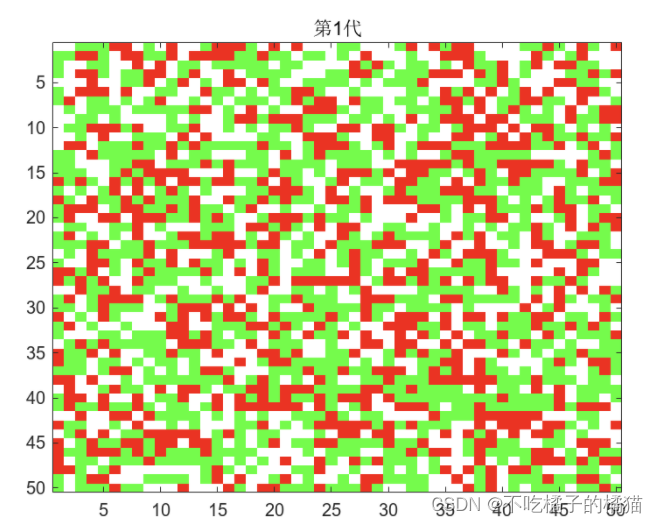

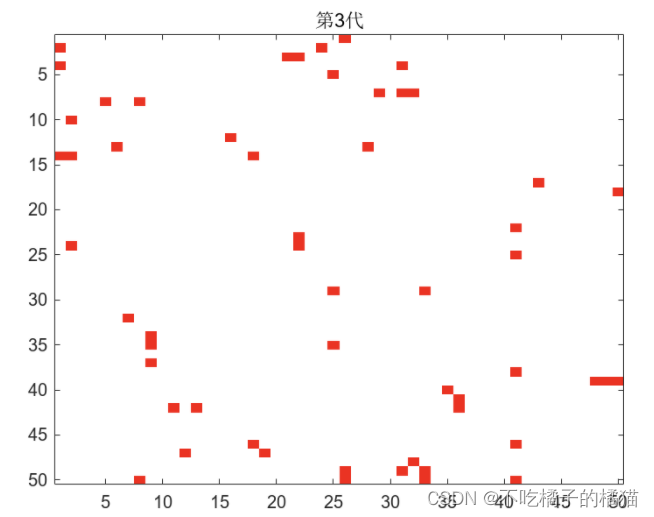

例3:種群繁殖模擬(以性別比例為例)
% 初始化參數
gridSize = 50; % 定義格子空間大小
nSteps = 100; % 模擬步數
initialDensity = 0.1; % 初始種群密度
reproductionRate = 0.05; % 繁殖率
mortalityRate = 0.02; % 死亡率
foodSupply = rand(gridSize); % 食物供應隨機分布% 初始化格子空間
populationGrid = zeros(gridSize, gridSize, nSteps);
genderRatioGrid = zeros(gridSize, gridSize, nSteps); % 性別比例,假設初始時0.5(1代表全雄性,0代表全雌性)% 初始種群和性別比例
populationGrid(:,:,1) = rand(gridSize) < initialDensity;
genderRatioGrid(:,:,1) = 0.5 * ones(gridSize);% 元胞自動機主循環
for t = 2:nStepsfor x = 1:gridSizefor y = 1:gridSize% 獲取鄰居索引,考慮周期邊界條件[neighX, neighY] = meshgrid(x-1:x+1, y-1:y+1);neighX = mod(neighX - 1, gridSize) + 1;neighY = mod(neighY - 1, gridSize) + 1;% 計算鄰居的平均食物供應avgFoodSupply = mean(mean(foodSupply(neighX, neighY)));% 更新種群和性別比例currentPopulation = populationGrid(x, y, t-1);currentGenderRatio = genderRatioGrid(x, y, t-1);newPopulation = currentPopulation + reproductionRate * avgFoodSupply * currentPopulation - mortalityRate * currentPopulation;newGenderRatio = currentGenderRatio; % 可以添加基于食物供應或其他因素的性別比例調整規則% 更新狀態populationGrid(x, y, t) = newPopulation;genderRatioGrid(x, y, t) = newGenderRatio;endend
end% 可視化最終步驟的種群密度
imagesc(populationGrid(:,:,end));
colorbar;
title('Final Population Density');
xlabel('X');
ylabel('Y');運行效果:
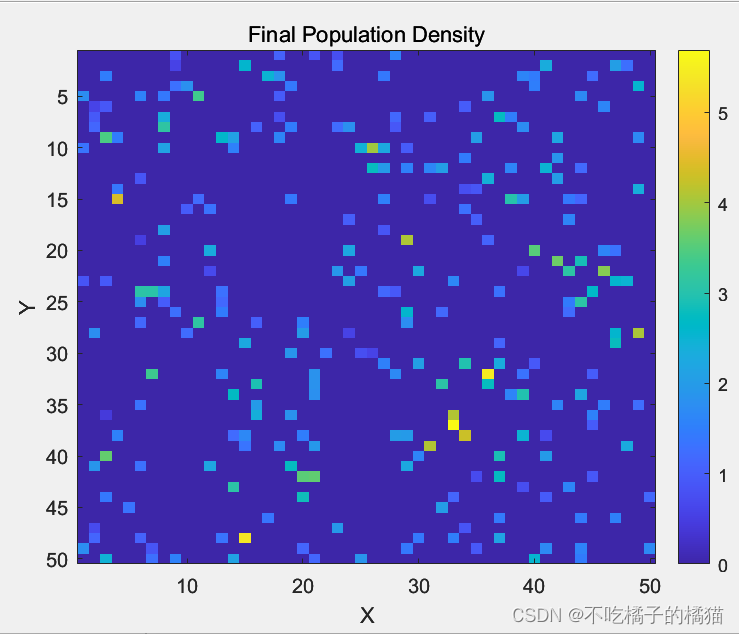

位運算)
)





)

)

)



)

)
的使用和示例)